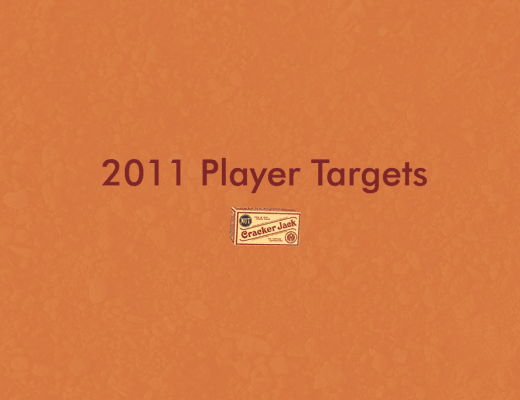Each year, fantasy baseball has some horribly disappointing players. Drafting these players is kind of like when you pay a ton of money for a diamond ring, give it to your wife and then realize that it’s cubic zirconia yet the store owner refuses to let you return it and then your wife leaves you for that stupid jock from the gym.
This problem is compounded if your disappointing player stays healthy all year. If your play is disappointing from injury then at least you can bench him and move on. But, if your high draft pick is healthy and playing like poop then, well, you’re in a crappy situation because you usually keep him in the lineup and keep hurting yourself each week as you wait for him to improve.
In this post, let’s take a look at the 10 worst offenders of being high draft picks who stayed healthy but played poorly for you. Perhaps we can learn something about why we should have avoided each of them.
Alex Gonzalez (SS), ADP 154, 2011 Roto Value -4.4: Gonzalez was drafted as a starting SS for most fantasy teams after a 23 HR and 88 RBI season but he played so poorly throughout 2011 that you had to either bench or cut him. One red flag was a GB/FB rate in 2010 that was unlike any previous year of his long career (.66 versus .80 over previous 4 years) which may have spiked his HR total in 2010 because more fly balls mean more home run chances. Gonzalez had been in the majors since 1998 and had shown that he’s not a shortstop who you can rely on for 20+ HR each year. You knew you were getting a low batting average and if you put stock in his high RBI and Run totals from 2010 then that was a lesson in the fact that RBI and Runs are often out of a hitter’s control and not reliable predictors.
Ryan Ludwick (OF), ADP 136, 2011 Roto Value -3.8: Why was Ludwick drafted so high in 2011 drafts? It was in 2008 that he had an incredible breakout year with a .299 average, 37 HR, 104 R and 113 RBI. In 2009, he took it down a notch in all categories (.265/22/63/97) and then he dropped even more in 2010 (.251/17/63/69). It had become more clear each year that 2008 was a fluke but, in 2011, he was still drafted in the range of starting fantasy outfielders. Don’t put stock into one lucky year a player had three years ago.
Delmon Young (OF), ADP 116, 2011 Roto Value -3.2: Young tricked quite a few people in his fifth full MLB season last year. After four years, it seemed he took a big step in 2010 with a high batting average, decent HR totals and big RBI numbers. However, there were red flags about his 2010 season including a GB/FB rate that was much lower than any other year for him (resulting in higher HR numbers) and a batting average with RISP that was 50 points higher than his season average (resulting in inflated RBI numbers). The only other positive element to owning Young is usually a good average but a lower than expected BABIP sunk that down and made him even less valuable.
Vernon Wells (OF), ADP 100, 2011 Roto Value -3.1: The Angels and fantasy owners paid a hefty price in order to own Wells last year. After cracking 31 HR in 2010 with decent numbers all around, owners expected to get more of the same in 2011. While his power wasn’t a total fluke since he hit 25 in 2010, his average crashed down to painful levels (.218) that caused havoc to your team. In 9 MLB seasons, he never had a year like it and unfortunately it was mostly a case of horrible luck due to a .214 BABIP versus a .254 expected BABIP (resulting in a lower batting average). In draft plans, you can’t really account for bad luck but it does happen.
Colby Rasmus (OF), ADP 93, 2011 Roto Value: -4.0: In his second MLB season, Rasmus posted a .276 AVG with 23 HR and 12 SB. His draft stock was high in 2011 since there was hope that he would continue to grow in his third year. The warning signs were there to show that 2010 was a fluke though. His .354 BABIP was unsustainable (inflating his AVG) and his 15% HR/FB was much higher than his expected HR/FB rate (resulting in more HR). It painted a picture of him being incredibly lucky in 2010 which is why his batting average (.225) and HR’s (14) both crashed in 2011. Don’t buy into numbers inflated by fluky BABIP or HR/FB numbers.
Martin Prado (OF), ADP 73, 2011 Roto Value: -3.1: Prado had two straight seasons with a .307 average and had come off a year with 100 Runs and 15 HR. There weren’t any indicators that his average or power were a fluke. Much like Wells, this was a case where bad luck struck as his power numbers didn’t dip much but his average dropped down to .260 due to a lower BABIP than expected. Being on base less meant less Runs too which should be a lesson to not put as much stock into Runs and RBI’s as they are products of opportunity.
Jayson Werth (OF), ADP 50, 2011 Roto Value: -2.3: In 2009, Werth smashed 36 HR which were inflated by a fluky HR/FB rate. In 2010, his HR’s (27) returned to a more sustainable rate but his batting average was inflated to .296 by a high BABIP. While he was lucky in two different ways in the previous two seasons, those both dropped to unlucky levels in 2011 which dropped his HR’s and AVG tremendously. Not only that, he was in a weaker run-producing lineup which dropped his RBI and Runs totals. A change in scenery should be noted when evaluating players each season.
Andre Ethier (OF), ADP 38, 2011 Roto Value: -1.9: Ethier typically delivers high batting average but owners also saw power too in 2009 when he hit 31 HR. Despite only 23 HR in 2010, owners still thought they might get a .300 hitter with 30 HR power in 2011. However, other than that one 31 HR year, he had never shown to be a strong HR hitter. In 2011, he had horrible luck which led to only 11 HR. A weird GB/FB rate meant less FB and a weird HR/FB rate meant less HR for each FB which was a perfect storm for Ethier resulting in tiny HR totals. The low HR totals created lower Runs and RBI totals in addition to sad fantasy owners. A bounceback year is upcoming.
Brian McCann (C), ADP 30, 2011 Roto Value: -1.6: McCann was drafted to deliver solid production from a weak position. Oddly, McCann did everything that he normally does (20+ HR, .270 AVG) but his Runs (51) and RBI (71) totals were career lows and greatly affected his value. The Braves produced less runs than expected overall but this was something that’s almost impossible to predict. Unfortunately for McCann owners, it was simply a case of poor luck since McCann did what he normally does otherwise.
Carl Crawford (OF), ADP 15, 2011 Roto Value: -2.4: Crawford normally delivers premier SB numbers with good batting average and fair power. In 2011, he was in a new lineup and his power numbers continued to be fair but his BABIP was much lower than his expected BABIP and that bad luck sunk his AVG to .255. The biggest pain for owners was that his SB numbers plummeted from his usual 50+ to 18. His walk rate dropped and he was on base 80 times less than in 2010 which may have hurt his SB opportunities as well as his usual high Run totals. If speedsters can’t get on base due to bad luck, it effects their two best assets (runs and SB’s). Drafting Crawford or players like him early is a major risk due to his lack of HR power, which you can only get in early rounds, so the results are catastrophic when he doesn’t even deliver in his speed skills. Be wary of paying too much for speed early.
Interesting side note: Crawford’s 2010 Rays had the second most SB attempts and the 2010 Red Sox had the least attempts in the MLB. In 2011, the Sox did improve to just the 18th most SB attempts while the Rays had the most attempts in the MLB. Differing managerial styles between old teams and new teams can have a great effect on player value.
So, what are the biggest lessons we learned from these horrible performances last year? Well, here’s a recap:
- Pay attention to GB/FB and HR/FB rates for players who had higher HR totals than normal last season. If they don’t match previous career norms, don’t expect the high HR’s to continue.
- Compare BABIP to xBABIP when a player had a higher AVG than normal last season. If the BABIP is higher than expected then temper your expectations on that AVG continuing.
- If a player had high RBI totals, look at his AVG with RISP to see if he got lucky in that area.
- If a player’s best assets are RBI’s and Runs then don’t get too excited since those are products of opportunities and HR and AVG are more in the player’s control.
- When a player moves to a new team, look at how SB’s or Runs and RBI’s might be altered. The team or manager have a direct effect on those numbers.
- Look at recent history of a player instead of putting stock into what they did many years ago.
- If the player has a long career history then you can use past history to show that a sudden career year is simply a fluke. Rely on a full player history rather than one year.



